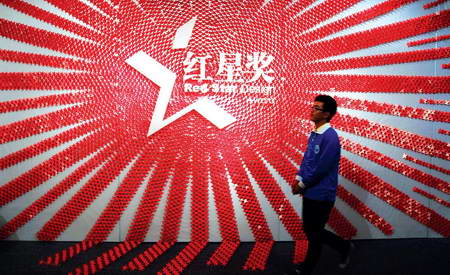Redesigning China's creative image
 A manwalking past adisplay at the design congress.[CFP]
|
|
|
With two major design events currently underway in the capital, China is transforming its design image to one of innovator in attempt to shed its often-used label of imitator. In recent years the government has initiated several projects to develop the nation's creative industries with the inaugural Beijing International Design Week coinciding with the Icograda World Design Congress and drawing significant support.
The week of design events is the largest-scale design fest ever to be held in China, involving all aspects of design life from industrial design to green technologies and fashion.
The comprehensive showcase of events has attracted over 100 speakers as well as more than 1,000 designers from around the world, according to Li Danyang, director of publicity. "People have been showing great interest in the festival since it opened Saturday and all the exhibitions held have been well attended up until now," Li added.
Wang Min, dean of the design department at China's Central Academy of Fine Arts, who is also the academic director of design week, expressed his confidence in the future of China's creative industries, saying that the combined events held in Beijing will "help to broaden Chinese designers' eyesight and bring fresh international design concepts and elements to China's design world."
"By holding such an event we are looking forward to helping redefi ne China's role in global design, thus building an international design center with original creativity," Wang explained.
Both events are considered by policymakers as leverage to boost China's creative industries.
"Beijing International Design Week will be the landmark activity of Beijing's design world and will be held once a year. It will surely help to boost communication between Beijing and the international design world," commented Beijing Deputy Mayor Cai Fuchao during his speech at the forum Design, Development and National Strategy.
Cai said the Beijing government has been actively promoting creative industries by all means possible, including the establishment of 21 Creative Industries Gardens across the city. "More than 500 million yuan (US$73.20 million) has been spent to help develop creative industries since 2006," Cai added.
He said that the government will continue to adopt a wide range of steps to promote the development of design in terms of both industry and culture, adding that one of the government's goals is to attract international design talent to stay and work in Beijing.
With the aim of offering international designers a platform to work from in China, the first Design Service Center (DSC), established by Beijing Gehua Cultural Creative Industry Center, was launched Monday. Aside from providing workshops for designers, the center also o. ers a range of services such as working teams to support foreign designers and consulting services on Chinese law about copyright, as well as daily life assistance.
"We have attracted 120 designers both from home and abroad to our center before [the center's] openingv day," said Liu Xiaolin, DSC's planning director. "A series of publicity work will also be done to help foreign designers become well understood by Chinese people."
In recent years, "design" has been a buzzword in Beijing and across the country, signifying a transformation shift from both the government and Chinese people from a low-efficiency "made in China" manufacturing economy to an innovative "created in China" brand, according to Michael Keane, principal research fellow at the Australian Research Council Center of Excellence for Creative Industries and Innovation.
Keane has been living in China for several years, conducting thorough research with a focus on Chinese design with its own cultural elements. He said that he is confident of China's future as a creative country. His book Created in China: The Great Leap Forward (2007), has been widely accepted by the international design world.
"China has a deep and long history of culture, so why should it keep itself as a copycat?" Keane asked. "People from around the world are now paying more attention to the country than ever and I think Beijing will be another international center of design within 10 years."
 0
0 







Comments